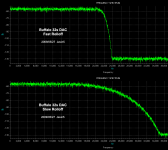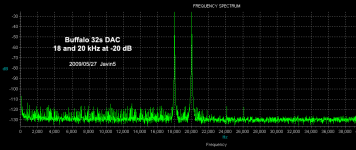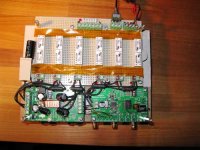Re: Question on single ended output
I am sure the the Buffalo 32S sounds better through the balanced outputs as you have rightly said. It probably sounds good single ended as well but perhaps some loss of fidelity. You can add a input amorphous core transformer to your integrated tube amplifier like the Lundahl 1676. Of course the most ideal situation would be to also use a fully differential, i.e. balanced integrated tube amp as well which most likely is not the case in your situation. I still think that the running the Buffalo in balanced mode and adding an input transformer to your integrated tube amp would be best and provide galvanic isolation on top of that. I use a pair in my gainclone to great effect. The point is you will maximize most of the benefits of balanced connection as opposed to what you suggest where you convert a balanced output back to single ended prior to running the cable between your dac and the tube amp. You will of course need to use a balanced interconnect if you use the former method and a single ended interconnect if you use the latter.
Anand.
wackyterbacky said:Good morning:
I know the Buffalo32S has Single Ended and/or Balanced outputs. I have a tube integrated amp with single ended inputs that are switchable from integrated (with Volume control) to power amp.
I am planning to test the Buff+ Volumite + power amp inputs and compare it to the Buff + integrated inputs.
I am concerned that I will be losing the maximum benefit by not using the balanced outputs, and I am thinking about using some sort of matching transformer on the Buff output to convert to single ended. Of course the Ballsie is also an option, but that adds 6 more op-amps ( albeit good quality ) per channel.
The amp has 470K input resistance integrated, 100K input resistance in power amp mode.
Can anyone comment on the pros / cons of adding a matching transformer?
Any recommendations on a specific transformer?
I am sure the the Buffalo 32S sounds better through the balanced outputs as you have rightly said. It probably sounds good single ended as well but perhaps some loss of fidelity. You can add a input amorphous core transformer to your integrated tube amplifier like the Lundahl 1676. Of course the most ideal situation would be to also use a fully differential, i.e. balanced integrated tube amp as well which most likely is not the case in your situation. I still think that the running the Buffalo in balanced mode and adding an input transformer to your integrated tube amp would be best and provide galvanic isolation on top of that. I use a pair in my gainclone to great effect. The point is you will maximize most of the benefits of balanced connection as opposed to what you suggest where you convert a balanced output back to single ended prior to running the cable between your dac and the tube amp. You will of course need to use a balanced interconnect if you use the former method and a single ended interconnect if you use the latter.
Anand.
Re: Sold Out
Any idea when the next sale will be?
Anand.
muizel said:Wow, second batch Buffalos sold out ! and that in the middle of
a financial crisis, that is what I call a suc6 😉
Congrats Russ and Brian and well deserved 😀
Rene.
Any idea when the next sale will be?
Anand.
Re: Buffalo 32s Rolloff
Nice plots! Thanks. 🙂
Javin5 said:With switch S3, you can select between fast and slow rolloff. Here is a plot which shows how the two modes look in the frequency domain. Most will probably prefer the fast mode because of its superior aliasing rejection.
Nice plots! Thanks. 🙂
Buffalo 32s Aliasing and Intermodulation
For those who are interested, here is another FFT-plot of an input of two sinewaves at 18 and 20 kHz at -20 dB. The remaining aliasing components at 24.1 and 26.1 kHz are vanishingly small. Also important, there is not a trace of intermodulation distortion at 2 kHz; which shows excellent design of the IVY-circuitry!
High frequencies at such high amplitudes are practically never present in music signals, so you may look at this as sort of a stress test; but the results are certainly reassuring.
Kurt
For those who are interested, here is another FFT-plot of an input of two sinewaves at 18 and 20 kHz at -20 dB. The remaining aliasing components at 24.1 and 26.1 kHz are vanishingly small. Also important, there is not a trace of intermodulation distortion at 2 kHz; which shows excellent design of the IVY-circuitry!
High frequencies at such high amplitudes are practically never present in music signals, so you may look at this as sort of a stress test; but the results are certainly reassuring.
Kurt
Attachments
Re: Re: Sold Out
There will be more pre-orders available next week, with a ship date about two weeks after the second batch. Trying to spread it out a little to keep it manageable.
Since the sales rate seems to be a little more rational, I will forgo the timers and such and just make them available.
nycavsr2000 said:
Any idea when the next sale will be?
Anand.
There will be more pre-orders available next week, with a ship date about two weeks after the second batch. Trying to spread it out a little to keep it manageable.
Since the sales rate seems to be a little more rational, I will forgo the timers and such and just make them available.
Re: Buffalo 32s Aliasing and Intermodulation
Indeed! Thanks Kurt.
Cheers!
Russ
Javin5 said:High frequencies at such high amplitudes are practically never present in music signals, so you may look at this as sort of a stress test; but the results are certainly reassuring.
Kurt
Indeed! Thanks Kurt.
Cheers!
Russ
After a couple of weeks, I love the new Buffalo32 ... very listenable ... female vocals (Norah Jones, The Cranberries, Carrie Underwood, and Sugarland) just sound amazing! I am listening to old cd's over again! This is truly an amazing product!
Dave Matthews acoustic is just amazing as well!
Dave Matthews acoustic is just amazing as well!
Hi Russ and Brian~!
I place an order last night (AU time) and I just wanted to make sure that all is good.
Name is Tom Booker.
Also I was planning on useing the same lcdps to power the digital section and the 4:1mux. I saw the output ratings for the lcdps and the power req of the two boards and they seemed to be fine. Is this a problem?
Also I know the crystal ball is a little cloudy and that you are redesigning it but... do you envisiage the Placid dps to have roughly the same footprint as the lcdps?
Can't wait to get the boards o(^-^)o
Kind Regards
Tom
I place an order last night (AU time) and I just wanted to make sure that all is good.
Name is Tom Booker.
Also I was planning on useing the same lcdps to power the digital section and the 4:1mux. I saw the output ratings for the lcdps and the power req of the two boards and they seemed to be fine. Is this a problem?
Also I know the crystal ball is a little cloudy and that you are redesigning it but... do you envisiage the Placid dps to have roughly the same footprint as the lcdps?
Can't wait to get the boards o(^-^)o
Kind Regards
Tom
Guys, how much time needs BUF to break-in? I launched my yesterday and must say the first few quarters were terrible, after two hours was much better, but I feel the bigger potential is there...
HaLo6 said:Tom, I use the LCDPS for both the digital section and a mux, it works great!
Awesome 😎
much love to the community ><
Hi,
I want to put low some low esr buffercaps at output voltages on the B32.
With the buffalo 1,2 it had a nice effect on sonics.
Russ, Brian, can you print/sign the locations of the output voltages from regulators on the B32 print?
P.s. Sended a few emails to the 'questions' adress at twisted pair. No answer in days..? why?
I want to put low some low esr buffercaps at output voltages on the B32.
With the buffalo 1,2 it had a nice effect on sonics.
Russ, Brian, can you print/sign the locations of the output voltages from regulators on the B32 print?
P.s. Sended a few emails to the 'questions' adress at twisted pair. No answer in days..? why?
Where exactly are you thinking of doing this? The EL caps on the B32 are OSCONs, so I doubt you will find a lower-ESR cap to replace them.
I think he means at the AVCC pins?
If so its really easy to find those caps.
C1 and C2.
But I doubt its going to do much to add capacitance since there are already extremely low ESR caps there, and anything they don't bypass will be sourced by the opamps at very low impedance.
Cheers!
Russ
If so its really easy to find those caps.
C1 and C2.
But I doubt its going to do much to add capacitance since there are already extremely low ESR caps there, and anything they don't bypass will be sourced by the opamps at very low impedance.
Cheers!
Russ
Nervous Norvis or Nurse Betty
Hi:
Stupid question here - better asked and answered here (I'm hoping) than not asked and risk the consequences, I suppose.
Are the Buffalo Board, and the LCBPS / LCDPS boards able to tolerate for the higher temperatures that lead free tin/silver solder require? The melting temperature is 340 degrees.
In advance, thanks. I bow at the feet of those reposed with such knowledge, and if you good answer my question, I'll also bow at the feet of your dogs, so long as they're potty trained.😀
Thanks,
Larry
Not sure if the DIY community shares my sense of humor, but I carry mine with me, sort of like American Express. And, seriously, thanks again for your thoughtful replies.
Hi:
Stupid question here - better asked and answered here (I'm hoping) than not asked and risk the consequences, I suppose.
Are the Buffalo Board, and the LCBPS / LCDPS boards able to tolerate for the higher temperatures that lead free tin/silver solder require? The melting temperature is 340 degrees.
In advance, thanks. I bow at the feet of those reposed with such knowledge, and if you good answer my question, I'll also bow at the feet of your dogs, so long as they're potty trained.😀
Thanks,
Larry
Not sure if the DIY community shares my sense of humor, but I carry mine with me, sort of like American Express. And, seriously, thanks again for your thoughtful replies.
Re: Nervous Norvis or Nurse Betty
Do you mean just for the through hole components?
TH pads should be just fine with lead free solder. But just like any PCB so the dwell on a pad for too long.
Cheers!
Russ
Muser said:Hi:
Stupid question here - better asked and answered here (I'm hoping) than not asked and risk the consequences, I suppose.
Are the Buffalo Board, and the LCBPS / LCDPS boards able to tolerate for the higher temperatures that lead free tin/silver solder require? The melting temperature is 340 degrees.
In advance, thanks. I bow at the feet of those reposed with such knowledge, and if you good answer my question, I'll also bow at the feet of your dogs, so long as they're potty trained.😀
Thanks,
Larry
Not sure if the DIY community shares my sense of humor, but I carry mine with me, sort of like American Express. And, seriously, thanks again for your thoughtful replies.
Do you mean just for the through hole components?
TH pads should be just fine with lead free solder. But just like any PCB so the dwell on a pad for too long.
Cheers!
Russ
HaLo6 said:After a couple of weeks, I love the new Buffalo32 ... very listenable ... female vocals (Norah Jones, The Cranberries, Carrie Underwood, and Sugarland) just sound amazing! I am listening to old cd's over again! This is truly an amazing product!
Dave Matthews acoustic is just amazing as well!
Yes. When a woman sings through this device I want to kiss somebody. The sound is just amazing.
But...I think if all the other hardware is optimized to be on the darker side of sound Buffalo 32 can be little too much making the sound even darker. Imo, the DAC needs a bit bright or neutral electronics as companion to work correctly. In my case the match up is just perfect (NAD M3 and System Audio Ranger speakers). SA speakers are a bit on the bright side and I just love what this DAC can do to the sound.
Sound wise the main difference between Benchmark DAC1 and B32S seems to be that while DAC1 produces very detailed sound, it's function is more like taking the focus from actual music to these little details in the sound. Those small details are so forward and easily heard that they affect the percieved rhytm and melody, and many times you end up listening to the sound instead of the music.
B32S focuces more on the musical experience leaving these "fly's farts" in the background, but producing very interesting and dynamic soundscape. I think this is why B32s is so easy to listen to...no...infact you just listen to the music instead of B32. There is no B32s, at least thats how it feels like.
Great product! Thank you Russ & Brian!
B32S focuces more on the musical experience leaving these "fly's farts" in the background, but producing very interesting and dynamic soundscape. I think this is why B32s is so easy to listen to...no...infact you just listen to the music instead of B32. There is no B32s, at least thats how it feels like.
Great product! Thank you Russ & Brian!
- Status
- Not open for further replies.
- Home
- More Vendors...
- Twisted Pear
- Twisted Pear Audio - Buffalo32S (ES9018 DAC)


